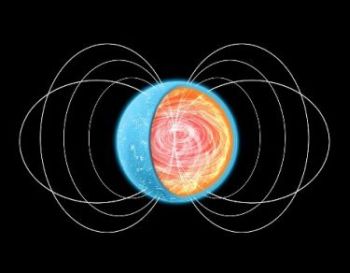Alicante, 10th June, 2013
The nuclear ‘pasta’, called as such due its similarity to the Italian food, limits the period of rotation of pulsars, and the University of Alicante has detected the first evidence of existence of a new phase of matter in the inner crust of neutron stars.
A study led by the University of Alicante, in which the National Research Council (CSIC) has participated, has detected what may be the first observational evidence of existence of a new exotic phase of matter in the inner crust of neutron stars (pulsars).
The latest issue of Nature Physics shows the results of a research project that addresses one of the unknowns in the field of X-ray pulsars, the existence of a limit higher than 12 seconds in the rotation periods of isolated neutron stars. This limit is actually due to the existence of new exotic phases of matter. Pulsars are neutron stars (ultracompact and strongly magnetized stars) in rotation, which emit electromagnetic radiation with amazing precision in their periodicity.
LASAGNA OR SPAGHETTI
As José A. Pons says, lecturer at the University of Alicante’s Relativistic Astrophysics Group and Director of the Department of Applied Physics, who led the work: "This may be the first observational evidence of existence of the phase of nuclear ‘pasta’ inside neutron stars, which may allow that future missions of X-ray observatories can be used to define aspects of how nuclear interaction works, which is not yet entirely clear”.
Nuclear Pasta, named for its resemblance to the Italian pasta, occurs when the combination of nuclear and electromagnetic forces, at densities close to the atomic nuclei, favours the ordering of the nucleons (protons and neutrons) in non-spherical shapes , as sheets or filaments (lasagna or spaghetti).
Daniele Viganò, a doctoral student at the University of Alicante notes that "the pulsars are born spinning very quickly, more than 100 times per second. However, their strong magnetic fields slow them down during their life, which increases the rotation period. Meanwhile, the inner crust corrodes the star's magnetic field and when it becomes weak, it is unable to further slow down the rotation of the star: the pulsar is "al dente", with a period of about 10-12 seconds".
Historically, radio pulsars (those detected in radio waves) were known to have a limit spin period with no theoretical explanation. Normally, this limit is thought to be a simple observational effect: those with slower rotation are less bright in radio and can not be observed. "Space missions in the past decade have identified a growing number of isolated X-ray pulsars, and to our surprise, none of them has a rotation period longer than 12 seconds, but there was no theoretical explanation for this phenomenon", Nanda Rea, a CSIC researcher, from the Institute of Space Sciences (Barcelona) explains.
This scientific article has been published as: "José A. Pons, Daniele Viganò, Nanda Rea. A highly resistive layer within the crust of X-ray pulsars limits their spin periods: Nature Physics. DOI: 10.1038/NPHYS2640.















